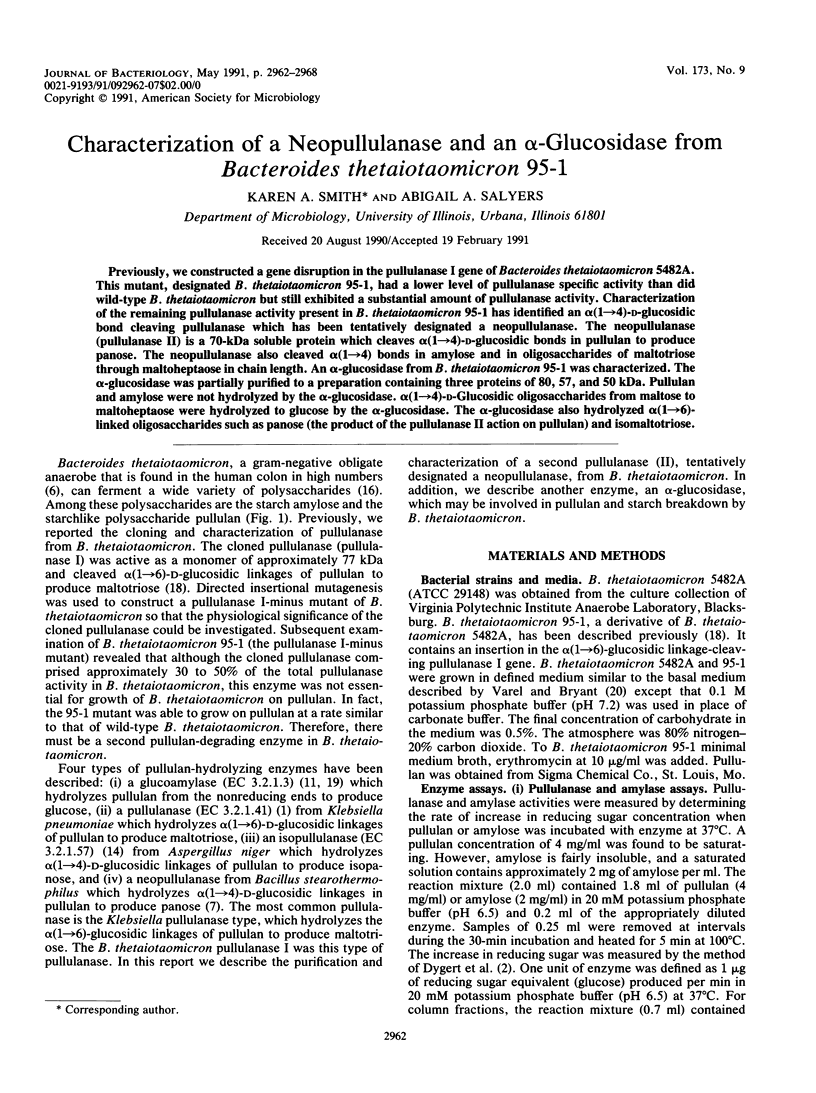Abstract
Previously, we constructed a gene disruption in the pullulanase I gene of Bacteroides thetaiotaomicron 5482A. This mutant, designated B. thetaiotaomicron 95-1, had a lower level of pullulanase specific activity than did wild-type B. thetaiotaomicron but still exhibited a substantial amount of pullulanase activity. Characterization of the remaining pullulanase activity present in B. thetaiotaomicron 95-1 has identified an alpha(1----4)-D-glucosidic bond cleaving pullulanase which has been tentatively designated a neopullulanase. The neopullulanase (pullulanase II) is a 70-kDa soluble protein which cleaves alpha(1----4)-D-glucosidic bonds in pullulan to produce panose. The neopullulanase also cleaved alpha(1----4) bonds in amylose and in oligosaccharides of maltotriose through maltoheptaose in chain length. An alpha-glucosidase from B. thetaiotaomicron 95-1 was characterized. The alpha-glucosidase was partially purified to a preparation containing three proteins of 80, 57, and 50 kDa. Pullulan and amylose were not hydrolyzed by the alpha-glucosidase. alpha(1----4)-D-Glucosidic oligosaccharides from maltose to maltoheptaose were hydrolyzed to glucose by the alpha-glucosidase. The alpha-glucosidase also hydrolyzed alpha(1----6)-linked oligosaccharides such as panose (the product of the pullulanase II action on pullulan) and isomaltotriose.
Full text
PDF






Images in this article
Selected References
These references are in PubMed. This may not be the complete list of references from this article.
- Dygert S., Li L. H., Florida D., Thoma J. A. Determination of reducing sugar with improved precision. Anal Biochem. 1965 Dec;13(3):367–374. doi: 10.1016/0003-2697(65)90327-1. [DOI] [PubMed] [Google Scholar]
- Enevoldsen B. S., Reimann L., Hansen N. L. Biospecific affinity chromatography of pullulanase. FEBS Lett. 1977 Jul 1;79(1):121–124. doi: 10.1016/0014-5793(77)80364-5. [DOI] [PubMed] [Google Scholar]
- Gherardini F. C., Salyers A. A. Characterization of an outer membrane mannanase from Bacteroides ovatus. J Bacteriol. 1987 May;169(5):2031–2037. doi: 10.1128/jb.169.5.2031-2037.1987. [DOI] [PMC free article] [PubMed] [Google Scholar]
- Gherardini F., Babcock M., Salyers A. A. Purification and characterization of two alpha-galactosidases associated with catabolism of guar gum and other alpha-galactosides by Bacteroides ovatus. J Bacteriol. 1985 Feb;161(2):500–506. doi: 10.1128/jb.161.2.500-506.1985. [DOI] [PMC free article] [PubMed] [Google Scholar]
- Holdeman L. V., Good I. J., Moore W. E. Human fecal flora: variation in bacterial composition within individuals and a possible effect of emotional stress. Appl Environ Microbiol. 1976 Mar;31(3):359–375. doi: 10.1128/aem.31.3.359-375.1976. [DOI] [PMC free article] [PubMed] [Google Scholar]
- Kobayashi H., Sano T., Ii K., Hizawa K., Yamanoi A., Otsuka T. Mixed connective tissue disease with fatal pulmonary hypertension. Acta Pathol Jpn. 1982 Nov;32(6):1121–1129. doi: 10.1111/j.1440-1827.1982.tb02093.x. [DOI] [PubMed] [Google Scholar]
- Kuriki T., Okada S., Imanaka T. New type of pullulanase from Bacillus stearothermophilus and molecular cloning and expression of the gene in Bacillus subtilis. J Bacteriol. 1988 Apr;170(4):1554–1559. doi: 10.1128/jb.170.4.1554-1559.1988. [DOI] [PMC free article] [PubMed] [Google Scholar]
- LOWRY O. H., ROSEBROUGH N. J., FARR A. L., RANDALL R. J. Protein measurement with the Folin phenol reagent. J Biol Chem. 1951 Nov;193(1):265–275. [PubMed] [Google Scholar]
- Laemmli U. K. Cleavage of structural proteins during the assembly of the head of bacteriophage T4. Nature. 1970 Aug 15;227(5259):680–685. doi: 10.1038/227680a0. [DOI] [PubMed] [Google Scholar]
- Linn S., Chan T., Lipeski L., Salyers A. A. Isolation and characterization of two chondroitin lyases from Bacteroides thetaiotaomicron. J Bacteriol. 1983 Nov;156(2):859–866. doi: 10.1128/jb.156.2.859-866.1983. [DOI] [PMC free article] [PubMed] [Google Scholar]
- PAZUR J. H., ANDO T. The hydrolysis of glucosyl oligosaccharides with alpha-D-(1-4) and alpha-D-(1-6) bonds by fungal amyloglucosidase. J Biol Chem. 1960 Feb;235:297–302. [PubMed] [Google Scholar]
- Salyers A. A., O'Brien M. Cellular location of enzymes involved in chondroitin sulfate breakdown by Bacteroides thetaiotaomicron. J Bacteriol. 1980 Aug;143(2):772–780. doi: 10.1128/jb.143.2.772-780.1980. [DOI] [PMC free article] [PubMed] [Google Scholar]
- Salyers A. A., Vercellotti J. R., West S. E., Wilkins T. D. Fermentation of mucin and plant polysaccharides by strains of Bacteroides from the human colon. Appl Environ Microbiol. 1977 Feb;33(2):319–322. doi: 10.1128/aem.33.2.319-322.1977. [DOI] [PMC free article] [PubMed] [Google Scholar]
- Smith K. A., Salyers A. A. Cell-associated pullulanase from Bacteroides thetaiotaomicron: cloning, characterization, and insertional mutagenesis to determine role in pullulan utilization. J Bacteriol. 1989 Apr;171(4):2116–2123. doi: 10.1128/jb.171.4.2116-2123.1989. [DOI] [PMC free article] [PubMed] [Google Scholar]
- UEDA S., FUJITA K., KOMATSU K., NAKASHIMA Z. I. Polysaccharide produced by the genus Pullularia. I. Production of polysaccharide by growing cells. Appl Microbiol. 1963 May;11:211–215. doi: 10.1128/am.11.3.211-215.1963. [DOI] [PMC free article] [PubMed] [Google Scholar]
- Varel V. H., Bryant M. P. Nutritional features of Bacteroides fragilis subsp. fragilis. Appl Microbiol. 1974 Aug;28(2):251–257. doi: 10.1128/am.28.2.251-257.1974. [DOI] [PMC free article] [PubMed] [Google Scholar]
- Whitaker J. R., Granum P. E. An absolute method for protein determination based on difference in absorbance at 235 and 280 nm. Anal Biochem. 1980 Nov 15;109(1):156–159. doi: 10.1016/0003-2697(80)90024-x. [DOI] [PubMed] [Google Scholar]




